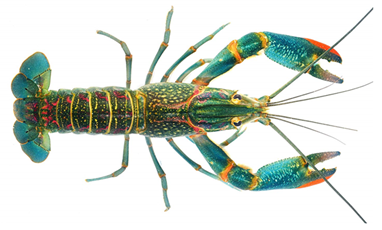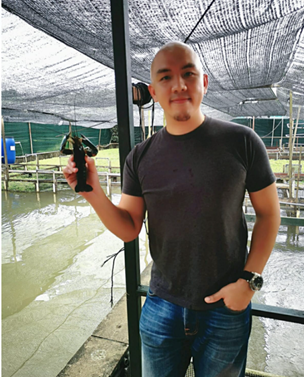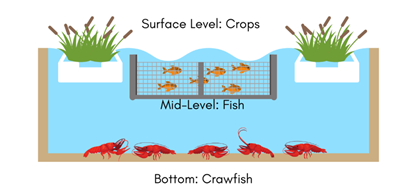Crawfish: “THE NEXT BIG THING” in the Aquaculture Industry Thanks to Breakthrough Technology

Complete the form below to unlock access to ALL audio articles.
A well-known breed of crawfish native to northern Australia, called Cherax quadricarinatus, is often considered to be a high-end, high-value product with huge global demand in the food industry — and demand is growing at a rapid rate.

Illustration of the crawfish. Credit: Live Aquaponics.
Now, a Singapore-based company is in the process of patenting technology and building a specific pathogen free (SPF) hatchery to increase the number of crawfish fry produced and lower their hatching mortality. This technology could change the face of global aquaculture.
Among the techniques and technologies developed to improve crawfish production is an auto separation system for crawfish, that has the ability to produce hundreds of thousands of juveniles each day. This auto separation system is versatile and could also be used for certain breeds of fish and shrimp.
The company’s founder, Desmond Chow, said the industry's traditional grow out farmers (grow out farming is the post-hatchery rearing process from fry to market size crawfish) had been hampered in the past by inefficient on-farm breeding processes that suffered large production losses.
"We've actually been able to extract the craylings from their parents efficiently and at the same time cut the labor by 90%, which is extremely efficient when you are looking at a commercial scale," Chow said.
"The major problem in the past was that production of craylings was an ad hoc affair. The males and females were randomly put in ponds with the hopes they will produce offspring and then much manual labor is required to separate and collect the fries. Through this process, the mortality of the craylings spikes, due to various reasons such as environmental changes, mishandling etc.".

A crawfish farm. Credit: Desmond Chow.
Crawfish farmer Alex Low, from Johor, said the collaboration with hatcheries like this one would be critical to the industry's growth. "For small crawfish farms like ours, we will require professional hatcheries to provide us with craylings, so we can focus on the “grow out” phase. That way, we can literally do three grow outs a year instead of only once every 12 months."
Professor Matthew Tan, co-chair for Sustainable Development in Agriculture and Fishery Sectors at Asia-Pacific Economic Cooperation (APEC), said this breakthrough technology was a big win for the industry. "One of the bottlenecks in the past has been the lack of knowledge on how to extract the craylings from the parents to prevent filial cannibalism." Commented Tan.
He continued "The new hatchery in Singapore will go a long way to providing a stable and high-quality supply of craylings to supply the domestic and potentially international industry, like any aquaculture industry, success often depends on having access to juveniles."
Crawfish growing opportunities
In a small breeding facility in Singapore, hundreds of thousands of eggs are hatched and reared to about 1 cm in size.
From there, the craylings are distributed to smaller farms in Singapore where they are grown to a table-sized product of up to 150 grams in weight.
A Singapore crawfish farmer, Vincent Eng, said “These crawfish require low maintenance. They grow fast, they grow very large! They are really easy to rear especially for new and inexperienced farmers. Anyone can grow it!”

Crawfish with craylings. Credit: Singapore Crawfish.
The key to unlocking Pandora’s box
Crustaceans in general still lack genomic resources compared with other widely-studied groups, such as insects and vertebrates. Genetics and the applications of next-generation sequencing (NGS) have expanded rapidly over recent years, unveiling many new and exciting areas of genomic research., and helping many academics and researchers to crack genomic puzzles. Cracking the genomic code for the crawfish will reveal novel insights into physiology, reproductive biology, response to environmental challenges and their evolutionary history.
In his lab, Chow and his team of scientists are using NGS to study how the crawfish genome responds to environmental challenges and to look at how they have evolved.
“We are working towards selective genetic mapping in the hope that we will be able to tailor our crawfish to suit different growing environments all over the world. Our crawfish could eventually contain high growth rate genes, bacterial resistance genes, or develop temperature or pH resistance capabilities” said Chow.
The market
In 2019, China alone produced upwards of 1.8 BILLION kg of crawfish (worth 48 billion USD) this has boosted their economy and fed millions of people. Despite producing huge amounts of crawfish, China still has extremely high demands for importing these little creatures, simply because the country has four seasons and the crawfish can’t survive the cold of winter. This causes live crawfish prices to spike during winter as demand climbs when supplies dwindle.
The global crayfish market size will further expand by 10.32 billion USD at a compound annual growth rate of 16% over the forecast period of 2021-2026. With the rise of the world’s middle class, a tasty crustacean such as crawfish is in increasingly high demand. In the future, it is also hoped that crawfish will eventually be recognized as a staple food source, as it is a great source of protein, vitamins and important amino acids unparalleled by various meats.
Investment required
With this innovation, as well as rearing opportunities, Chow is looking at partnering with food processing companies to create products such as ready-to-eat crawfish tails, crawfish instant noodles and deep-fried crawfish snacks amongst others.
However, Chow said the potential of the species as a growth aquaculture industry hinged on the level of investment over the coming years.
His company is raising a small investment to build the first high tech SPF crawfish hatchery in Singapore, capable of producing a minimum of 100,000 craylings per day. This will help with food sustainability and global food poverty as the craylings will be distributed to all countries who want to rear this high protein little crustacean.

Crawfish for food. Credit: Singapore Crawfish.
Chow has also helped paddy farmers in Indonesia and Malaysia by sharing his multi-cropping techniques. Here, he teaches rural farmers how to yield three crops – rice, crawfish and fish concurrently instead of a single paddy crop. This increases the farmer’s income by five times and increases food yields.

Diagram illustrating a crawfish-based multi-cropping system. Credit: Singapore Crawfish.

